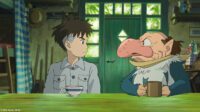Few films come to the 2023 London Film Festival more hotly anticipated than Martin Scorsese’s latest epic. Like most people with a serious interest in film, Martin Scorsese has been a central motivator for that interest since it first began. Goodfellas and Casino were among the first “adult” films I ever saw. Their verve and energy made them accessible to a teenager without sacrificing vicious intensity or poignancy. I’ve now seen nearly all his feature films and developed some hot takes about them. Maybe I should annoy people and write an article ranking them one day, that kind of controversy could do great things for this site! But yes, I do think there’s two kinds of Scorsese films, those where he’s just telling a story, albeit extremely well, and there’s those where he’s making Capital-A “Art”. Killers of the Flower Moon begins and ends as the latter, for the three or so hours in between, it’s merely the former.
The first scene is absolute gold. Black gold. There’s always an anxiety around the idea of a white filmmaker depicting indigenous people, see my Wind River articles, but Scorsese is a student of world cinema and with Killers of the Flower Moon, he supports my thesis that creating an appropriately accented cinematic form ought not to be beyond a sufficiently respectful and humble filmmaker. The opening sequence of Killers of the Flower Moon is mesmerizing, as the elders of the Osage country tribe gather to mourn the passing of one of their peers and express their fears that their way of life will not survive intact to the next generation. Outside, the young men of their tribe strike oil and the late guitarist and composer Robbie Robertson establishes himself as this film’s MVP.
From there we are introduced to our protagonist, Ernest (Leonardo DiCaprio) a close cousin to The Irishman’s Frank Sheeran, The Wolf of Wall Street’s Jordan Belfort, or Goodfellas‘ Henry Hill. A tiny, tiny man with the morals and backbone of an amoeba. Killers of the Flower Moon fits into this cycle of films, telling the history of America, which is, in Scorsese’s films, a history of weak, stupid, petty, and pliable men with no morals. they are little children peer-pressured into genocide. Like Sheeran, Ernest has just returned from the war, in his case, World War I. He won no medals or glory, by his own admission he’s lazy and a womanizer, and DiCaprio makes you wonder how anyone ever considered him attractive, giving another gurning performance that’s more than a little “French-fried purtayturs”.
Earnest has returned to make his fortune with his uncle, a giant of the Oklahoma plains, respected and loved by all when he ought to be feared. William King Hale (Robert De Niro) is another familiar Scorsese archetype. The casting of De Niro should help connect the dots between this man and Goodfellas’ Jimmy Conway, a loathsome man who hides his monstrousness behind faux concern and a good-will-to-thee smile. “King” explains how the oil has brought prosperity to the Osage and that many of their women now stand to inherit great fortunes—women like Molly (Lily Gladstone).
Molly is perhaps the only character in Killers of the Flower Moon who arrives as a breath of fresh air into Scorsese’s catalog. She’s not the harsh, unravelling paranoiac wives of Goodfellas or Casino, or the bold, pragmatic man-eater of The Wolf of Wall Street. She’s a calm, observant and respectable woman who loves her family, knows her own power and esteem. Molly understands the power her money gives her, but also knows the score—that power could be taken from her in a moment so she’s careful and measured in all things. Why a woman like that should be seduced by a wastrel like Earnest is a question the film doesn’t really give a satisfactory answer to. She’s amused by him, certainly, and he’s Leonardo DiCaprio, who used to be quite the sex symbol. So, we can maybe sympathize with her wanting to get in his pants. Despite Gladstone’s efforts, I wasn’t convinced. DiCaprio is the problem, somewhere between Titanic and now he seems to have forgotten how to be charming and sexy. Gladstone is wonderful onscreen and it’s a shame she’s given increasingly little to do as the film goes on.
So, we have our setup comprised of the sympathetic woman of means, the weak-willed widower, and the vile manipulator pulling the strings. Why does this film need to be three-and-a-half hours long again? I’ll confess, although I was never bored by Killers of the Flower Moon—chalk that up to Scorsese’s immense talent and the razor-like editing of Thelma Schoonmaker—it did start to feel repetitive, both within itself and within Scorsese’s own canon. There’s not many scenes that feel wholly extraneous, and Scorsese’s indulging the sympathetic viewer as much as he is himself. But, it must be said that when Scorsese said he realized after setting out that he was making a film about the wrong characters and decided to realign the film’s center around Molly, I think he was being overly generous with himself. Ernest is very much the center of Killers of the Flower Moon, and that’s a problem.
There was some debate when it was announced that Gladstone would be running for lead actress awards. With some arguing, the producers had blown her shot at a win by putting her in the more competitive block and others arguing that she should be wherever she damn well belongs. Having seen the film myself, she’s not the co-lead. She should be, but she isn’t. Scorsese has been criticized for diminishing the roles of women in his stories, mostly unfairly I think. Here, however, I’ve got to say I think there’s a case to be made, and it’s surprising because Molly is the biggest role for a woman in a Scorsese film since at least Casino and arguably the meatiest since Alice Doesn’t Live Here Anymore. Refocusing the story around Molly would’ve been better because we’ve seen Scorsese portray Ernests before, and Molly feels like breaking new ground.
That’s the trouble with Killers of the Flower Moon. Is is good? Yes, yes absolutely, very. It’s intense, vicious, angry, troubled, tragic, poignant, and atmospheric. It moves at a pace that not only shows you the story, it forces you to experience it and live amongst it. That’s why it’s three-and-a-half hours long. It draws it all out, makes you sit there with it, longer than you want to. It sheds light on an abhorrent chapter of U.S. history (aren’t they all?) and does so in a fashion that honors the victims of violence and empowers the culture they were killed to snuff out. Throughout the film “King” confidently asserts that the Osage people will all be extinct soon anyway, they’re just helping them through the door and making a buck or a hundred thousand in the process. Well, the Osage are still here a century later. Sadly, so are men like “King” and their dogsbodies like Earnest.
As I said, there are two Scorseses and the lesser of them made most of Killers of the Flower Moon. That lesser is still a master of his craft and one of the best Hollywood directors. The greater of them though is one of the best filmmakers who has ever lived. He shows up twice in Killers of the Flower Moon, once in that opening, and again at the very end. Scorsese signs off with one of the most left-field, audacious, heartbreaking, transparently personal and brilliant moments in the latter half of his catalogue. The film brings a tear to the eye just to recall it. It’s so humble, so sincere, and so moving, it elicited gasps and a stunned, respectful silence. If you watch the other three-and-a-half hours of this movie just to get to that moment, it would already have been time well spent.



![[L to R] Piper Laurie, Selma Hayek, and Robert Patrick as Mrs. Olson. Nurse Harper, and Coach Willis in The Faculty (1998). Screen capture off Paramount+.](https://filmobsessive.com/wp-content/uploads/2023/10/Faculty-6-200x134.jpg)

Excellent review ! I wonder why no one e has brought up the fact that in 1926 the first Native American filmmaker James Young Deer made a ninety minute black and white silent film about the Reign of Terror in Oklahoma called Tragedies of the Osage Hills ! By the way I think Heavens Gate is a better film than Killers of the Flower Moon !